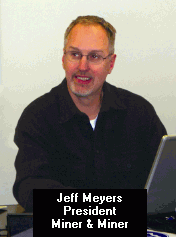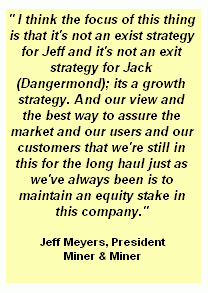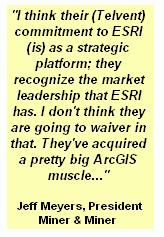 In
early December of l last year, Miner
& Miner was acquired by Telvent,
a company focused on the energy, transportation, and real-time traffic
markets, and whojust recently went public itself.Editor-in-Chief, Joe
Francica, spoke by phone with Jeff
Meyers, president of Miner and Miner
to get his thoughts on the acquisition and how he thinks the company
will be able to grow.
In
early December of l last year, Miner
& Miner was acquired by Telvent,
a company focused on the energy, transportation, and real-time traffic
markets, and whojust recently went public itself.Editor-in-Chief, Joe
Francica, spoke by phone with Jeff
Meyers, president of Miner and Miner
to get his thoughts on the acquisition and how he thinks the company
will be able to grow.Joe Francica (JF): What caught my attention regrading the Telvent/Miner and Miner deal was the implications for bringing Miner & Miner's product suite as well as the ArcGIS suite into the enterprise, and how that might be facilitated through Telvent.I'd just like to get your perspective on how that came about and whether that was one of the visions for making that happen.
 Jeff
Meyers (JM): I think
probably the key driver from the Telvent's perspective first is that
they have this strategy that they refer to as "the hour glass" and its
a little hard to get without a visual, but if you think of an hour
glass-shaped thing and in the middle of that the control center
applications (SCADA/EMS) and down below in the bottom of this thing,
all the monitoring and control devices and the metering devices in the
field.Telvent's strategy is using all that stuff in the bottom of the
hour glass in a more strategic and operational way in the top of the
hour glass.They think of ways data from the field, real-time data, can
be used in a more strategic and operational way.And that strategy is
referred internally as the "hour glass." So, that's kind of where ArcFM
fits.Above the "waist" of the hour glass are things like their gas
measurement applications and their liquids management suite and mobile
workforce management, and now ArcFM, a set of applications that kind of
help an enterprise first have better data about their network and where
it is in a static sense.Then, a place where real-time information and
spatial data can converge to make for better asset management and
better decisions, better work management, better outage management, all
three of those things.So, from the Telvent perspective, that's exactly
the driver for this deal.Not to put too fine a point on that, but no
one from Miner and Miner or Telvent is sort of so naive to think that
most of our user base or most of their user base doesn't already have a
lot of those pieces of technology so there are very few places where we
would go in and say, "its an all new SCADA and GIS here it is, one
solution; you buy it from one vendor.We have about 180 users or so,
and they all already have some SCADA system; some of them are Telvent
users now.But many have other flavors of SCADA/EMS, and many of
Telvent's existing users have some other flavor of GIS, so its really
about the infrastructure and the skill sets that can put those pieces
together as much as it is about having products in that integrated way.
Jeff
Meyers (JM): I think
probably the key driver from the Telvent's perspective first is that
they have this strategy that they refer to as "the hour glass" and its
a little hard to get without a visual, but if you think of an hour
glass-shaped thing and in the middle of that the control center
applications (SCADA/EMS) and down below in the bottom of this thing,
all the monitoring and control devices and the metering devices in the
field.Telvent's strategy is using all that stuff in the bottom of the
hour glass in a more strategic and operational way in the top of the
hour glass.They think of ways data from the field, real-time data, can
be used in a more strategic and operational way.And that strategy is
referred internally as the "hour glass." So, that's kind of where ArcFM
fits.Above the "waist" of the hour glass are things like their gas
measurement applications and their liquids management suite and mobile
workforce management, and now ArcFM, a set of applications that kind of
help an enterprise first have better data about their network and where
it is in a static sense.Then, a place where real-time information and
spatial data can converge to make for better asset management and
better decisions, better work management, better outage management, all
three of those things.So, from the Telvent perspective, that's exactly
the driver for this deal.Not to put too fine a point on that, but no
one from Miner and Miner or Telvent is sort of so naive to think that
most of our user base or most of their user base doesn't already have a
lot of those pieces of technology so there are very few places where we
would go in and say, "its an all new SCADA and GIS here it is, one
solution; you buy it from one vendor.We have about 180 users or so,
and they all already have some SCADA system; some of them are Telvent
users now.But many have other flavors of SCADA/EMS, and many of
Telvent's existing users have some other flavor of GIS, so its really
about the infrastructure and the skill sets that can put those pieces
together as much as it is about having products in that integrated way.JF: In this market, is it more important to have something that is extremely well-integrated or can most of these users that have these others systems "make do" with something that is more heterogeneous in nature.Telvent would come with your solutions up and down the "hour glass" so is it easier to do that or will companies be reluctant to make that move since these are such major technology shifts inside of a SCADA, for example?

JM: You know, I really think that it would be unusual to just adopt an all Telvent solutions, unless there were some other key drivers such as their SCADA system was due to be replaced and they were going through a major technology upgrade.I think it's much more likely that they fact that these applications have been used and can be used in an integrated way, will work better in a heterogeneous way as well.So, if I'm an existing Telvent customer and my GIS has reached the end of its lifecycle, I can feel pretty good that that's company can take me to the next level of GIS and know that its integratable.Similarly, if I'm an ArcFM user and my SCADA/EMS is at the end of its lifecycle, I can feel confident that the next generation of SCADA is going to work well with my GIS.But if neither of those things are true, if I'm just a user that doesn't have Telvent and doesn't have ArcFM and I say, 'OK, now I've got to go out and look for a new GIS because my GIS is at the end of its lifecycle, I still think it makes sense that a GIS that has been well integrated and has thought through all of those real time issues, and the framework, the infrastructure for integration would be a good choice even if the target SCADA system isn't Telvent.

JF: How many companies, and I'm thinking more of the larger utilities, whether its public or private, would be at this time looking to upgrade and make these major changes to either SCADA or GIS?
JM: I can speak more to the GIS end than the SCADA end because I'm not as dialed in.I think there are number of larger utilities, not just in North America, but around the world, that have legacy GIS that's nearing the end of its lifecycle, so we're seeing a lot of activity in that end: Detroit Edison, Oklahoma Gas and Electric, Consolidated Edison, Excelon...those companies with a lot of investment in data and legacy GIS technology.Thinking about the cost of migrating that thing forward, and at the same time, if I have some kinds of technology that is dated, it might cost just as much to move forward to my vendors new generation as it costs me to look at and see what's out there and take on a whole new flavor.So, from the GIS perspective, we're definitely seeing some vendor's products nearing the end of their lifecycle.In fact, Joe, much more so than 'greenfield' or people just out now shopping for GIS.
JF: Has there been much visibility raised about asset protection and hence the need for more asset management given terrorist concerns or just investment concerns?
JM: I haven't seen a lot of additional investment in GIS because of homeland security issues.We deal more with it in data modeling but I don't think its been a key driver.I think the key drivers continue to be things like Sarbannes-Oxley, with more focus on good asset management, more focus on every financial decision, reliability concerns; then same sort of things that have been key drivers but certainly at the large utility level, the merger and acquisition thing making it seem sort of mandatory that technology be extensible and be able to work in different business environments.
JF: Do you think the merger by Telvent will help you get into more of Telvent's markets such as oil and gas, transportation, and real-time applications?
JM: That is certainly a very big part of it.I think its a growth strategy in two dimensions.First and probably foremost, in the global energy distribution field where Telvent is very strong, especially in Latin America and Asia, such as China, and certain parts of Europe.And to be very frank, ArcFM's market dominance in North America has been very difficult for us to replicate elsewhere.We are no where near as successful in Latin America as we should be or in Asia for that matter, as we should be. So, that's the first dimension, but beyond that, the thing that you mentioned, is also very valid.Telvent is looking for a more replicatible, predictable solution in other areas of their IT business where they use GIS in traffic, transportation and environment.Those are three key areas.We think ArcFM has a lot of enterprise management tools that can help companies that use spatially-distributed asset data and need to manage that.So, that even without some of the fancier, specific functionality that they see in electric and gas that ArcFM contains, even without that stuff, just the enterprise nature of it, the multi-user editing, the version management; all of the strengths that it has are going to be real positive.And over time, we're going to build functionality to support those markets as well.
JF: And is that going to bubble up in the decision-making process, say, out of the engineering side and into the financial side?
JM: Sure, in fact that's the very ultimate, the very top of the "hour-glass" idea.You can almost imagine there is this control center and above that is this sort of operating and engineering applications, and at the very top of that is the strategic asset management decision-making tools, enterprise resource planning (ERP).There will be more granular and richer data sets that drive those asset decisions.
JF: Will there be other players involved such as SAP or Oracle?
JM: Telvent already has a strong SAP practice and that's a target partnership of theirs.I think those are the people and with Oracle, with their designs on the ERP space, those are the people that are going to play at the top for sure.
JF: I assume Telvent was pretty comfortable buying into Miner and Miner even though you have more of a focus on a single product base, i.e.the ESRI suite, and that's where your experience lies.Would you foresee any possibility that Miner and Miner branches out into having to learn other technologies to service other Telvent customers?
JM: I really don't, Joe.I think it is a strategic focus of Telvent to be a partner of ESRI's. That's a thing that we are really focused on.It certainly could turn out that Telvent will support other customer with existing products. But Miner and Miner's focus will be to build ArcFM and sell it and deliver it.We're going to work on ArcGIS; that's what we know and that's what we're good at; that's our commitment to ESRI, really.
JF: What caught my eye in the press release by Telvent was the opportunity to buy all of Miner and Miner.This was a bit of a surprise to me because I know that Jack owns part of Miner and Miner and so at some point in the future there is a possibility of Jack not owning part of Miner and Miner.So, it seemed a bit of a risk to me that in the future Telvent would look to other solutions and that ESRI technology would not be well represented.
JM: I don't know so much about that, Joe.I think the focus of this thing is that it's not an exist strategy for Jeff and it's not an exit strategy for Jack; it's a growth strategy.And our view and the best way to assure the market and our users and our customers that we're still in this for the long haul just as we've always been is to maintain an equity stake in this company. So, when you decide you're going to do a deal like this it gets kind of complicated.If you're just going to sell you company lock, stock and barrel, that's a relatively simple thing.I know these guys at the top of the Telvent organization pretty well; we've been through a lot in the last almost nine months in working this thing out, and I think their commitment to ESRI as a strategic platform; they recognize the market leadership that ESRI has.I don't think they are going to waiver in that.They've acquired a pretty big ArcGIS muscle and I don't think it would make much sense if they weren't serious about that being the strategic platform.